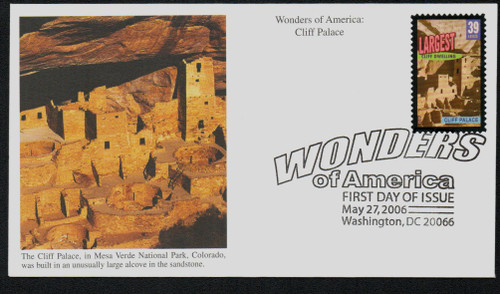
2006 39c Bering Glacier, Larg. Glacier
# 4036 - 2006 39c Bering Glacier, Larg. Glacier
$2.95
U.S. #4036
Bering Glacier
Wonders of America
Bering Glacier
Wonders of America
Issue Date: May 27, 2006
City: Washington, DC
Quantity Issued: 204,000,000
Printed by: Avery Dennison
Printing Method: Photogravure
Perforation: Serpentine die cut 10 ¾
Color: Multicolored
City: Washington, DC
Quantity Issued: 204,000,000
Printed by: Avery Dennison
Printing Method: Photogravure
Perforation: Serpentine die cut 10 ¾
Color: Multicolored
The Bering Glacier, near Cordova, Alaska, is about 126 miles long and about 30 miles wide near its end in Vitus Lake. Low temperatures in the region allow large amounts of snow to build up and turn into ice. At some point, the ice becomes so thick that it begins to move downhill under the pressure of its own weight.
Heat from the friction of movement and from the earth’s interior melts some of the glacier’s bottom layer, but the top remains stiff and rigid. The surface often fractures and forms deep crevasses as the glacier flows over uneven or steep terrain.
A glacier may suddenly begin to move very rapidly – as much as 16 feet per hour. This rapid flow, or surging, continues for only a year or two. The Bering Glacier surges every 20 years or so. The surges are generally followed by periods of retreat, so despite the periodic advances, the Bering Glacier has been shrinking overall.
The Glacial retreat has caused more earthquakes in the region. The weight of ice in the Bering Glacier is usually enough to stabilize the boundary between the Pacific and North American tectonic plates. As the Glacier shrinks, however, the pressure of the ice is less. This allows the rocks along faults to move more freely, resulting in more earthquakes.
U.S. #4036
Bering Glacier
Wonders of America
Bering Glacier
Wonders of America
Issue Date: May 27, 2006
City: Washington, DC
Quantity Issued: 204,000,000
Printed by: Avery Dennison
Printing Method: Photogravure
Perforation: Serpentine die cut 10 ¾
Color: Multicolored
City: Washington, DC
Quantity Issued: 204,000,000
Printed by: Avery Dennison
Printing Method: Photogravure
Perforation: Serpentine die cut 10 ¾
Color: Multicolored
The Bering Glacier, near Cordova, Alaska, is about 126 miles long and about 30 miles wide near its end in Vitus Lake. Low temperatures in the region allow large amounts of snow to build up and turn into ice. At some point, the ice becomes so thick that it begins to move downhill under the pressure of its own weight.
Heat from the friction of movement and from the earth’s interior melts some of the glacier’s bottom layer, but the top remains stiff and rigid. The surface often fractures and forms deep crevasses as the glacier flows over uneven or steep terrain.
A glacier may suddenly begin to move very rapidly – as much as 16 feet per hour. This rapid flow, or surging, continues for only a year or two. The Bering Glacier surges every 20 years or so. The surges are generally followed by periods of retreat, so despite the periodic advances, the Bering Glacier has been shrinking overall.
The Glacial retreat has caused more earthquakes in the region. The weight of ice in the Bering Glacier is usually enough to stabilize the boundary between the Pacific and North American tectonic plates. As the Glacier shrinks, however, the pressure of the ice is less. This allows the rocks along faults to move more freely, resulting in more earthquakes.







